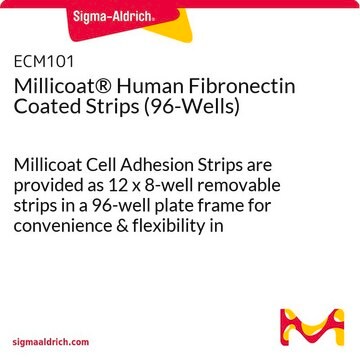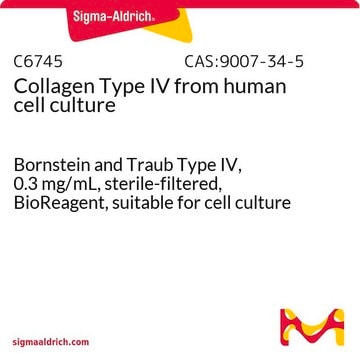F0556
Human Fibronectin
from human fibroblasts, liquid, ~0.5 mg/mL, suitable for cell culture
Synonym(s):
Fibronectin
About This Item
Recommended Products
Product Name
Fibronectin solution human fibroblasts, cell culture derived, ~0.5 mg/mL, sterile-filtered, BioReagent, suitable for cell culture
biological source
human fibroblasts
Quality Level
sterility
sterile-filtered
product line
BioReagent
form
solution
mol wt
31 kDa
packaging
pkg of 100 μL
concentration
~0.5 mg/mL
technique(s)
cell culture | mammalian: suitable
impurities
HBSAG, none detected
HCV, none detected
HIV-1/HIV-2, none detected
NCBI accession no.
UniProt accession no.
binding specificity
Peptide Source: Collagen
shipped in
dry ice
storage temp.
−20°C
Gene Information
human ... FN1(2335)
Looking for similar products? Visit Product Comparison Guide
General description
Application
- It is used in purification of human extracellular matrix (ECM)
- Coating of tissue culture plates with extracellular matrix components
- Used during cell culture (For xeno-free, feeder-free culture the cells were passaged in to human fibronectin along with other components)
Fibronectin from human plasma can be used with epithelial cells, mesenchymal cells, neuronal cells, fibroblasts, neural crest cells, and endothelial cells. It is recommended for use as a cell culture substratum at 1-5 μg/cm2 or 0.5-50 μg/mL. The optimal concentration does depend on cell type as well as the application and research objectives.
Biochem/physiol Actions
Components
Caution
Preparation Note
Storage Class
11 - Combustible Solids
wgk_germany
WGK 3
flash_point_f
Not applicable
flash_point_c
Not applicable
ppe
Eyeshields, Gloves, type N95 (US)
Choose from one of the most recent versions:
Already Own This Product?
Find documentation for the products that you have recently purchased in the Document Library.
Customers Also Viewed
Articles
Extracellular matrix proteins such as laminin, collagen, and fibronectin can be used as cell attachment substrates in cell culture.
Protocols
Dilute fibronectin for cell attachment, varying per cell type. Coating protocol, products, and FAQs provided.
Our team of scientists has experience in all areas of research including Life Science, Material Science, Chemical Synthesis, Chromatography, Analytical and many others.
Contact Technical Service








